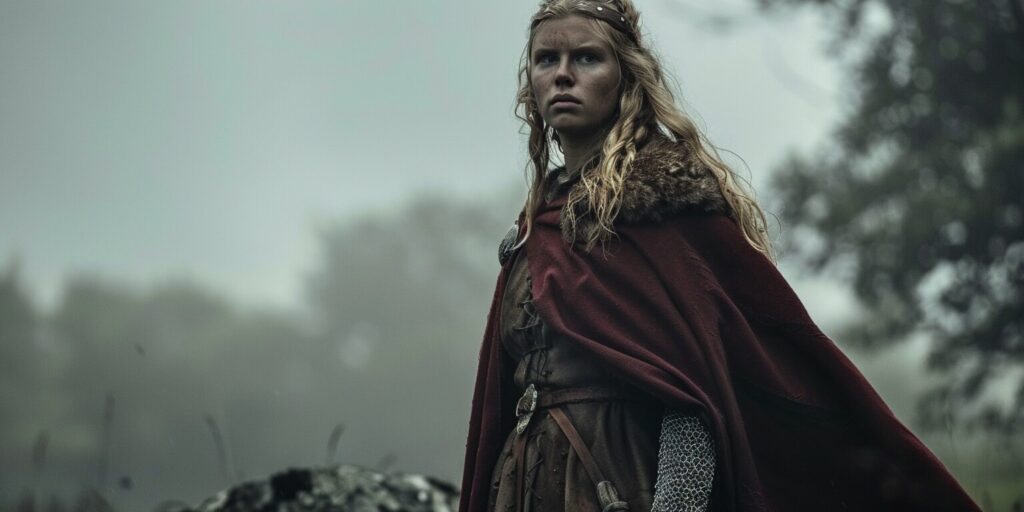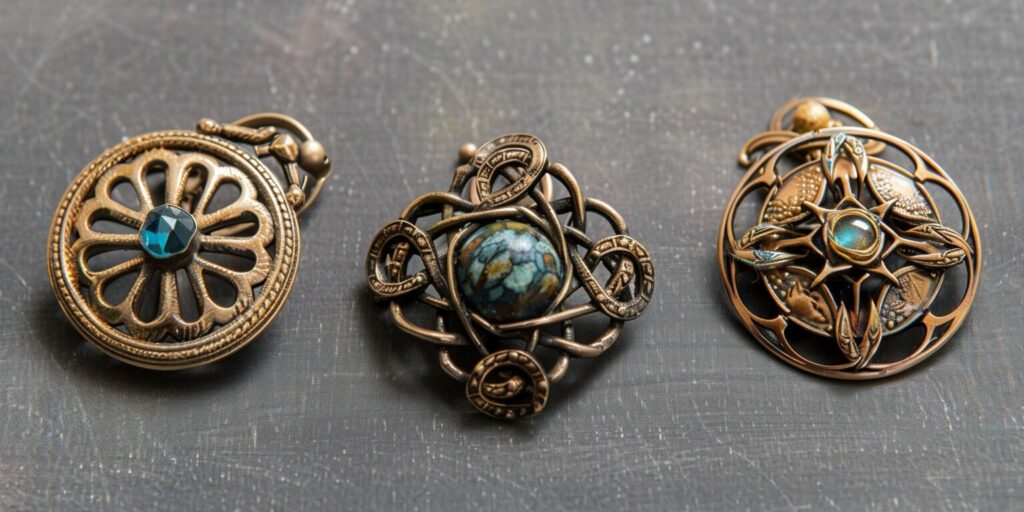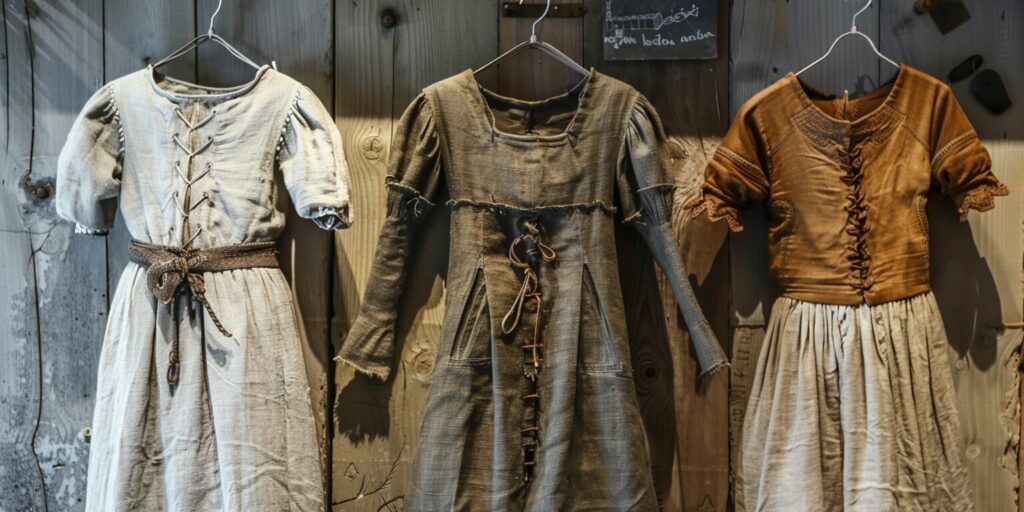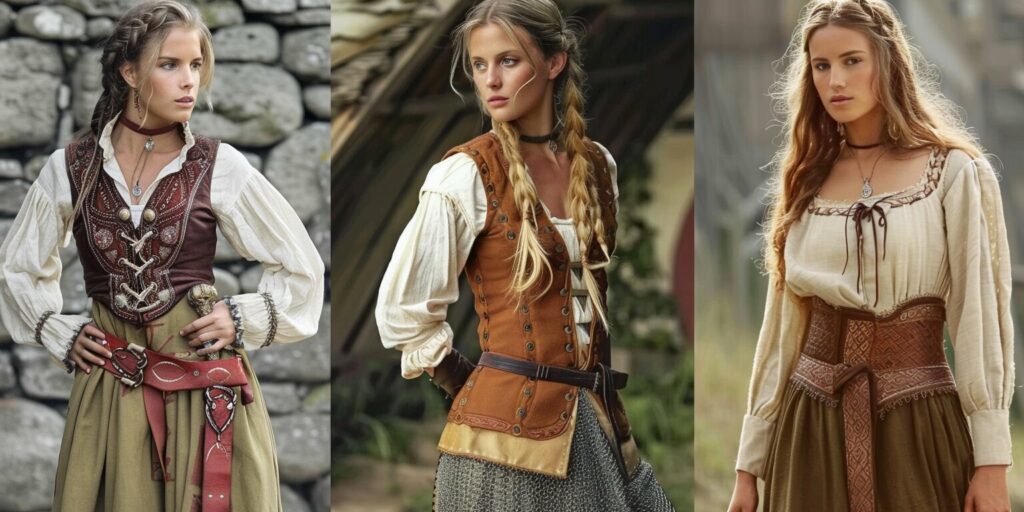Viking Clothing and Jewelry, Vikings
Traditional Viking Women Clothing: Styles and Materials
Viking women’s clothes are famous for their unique styles and useful materials. They were made to handle harsh weather and show social status. The clothing usually had many layers, with linen underdresses and woolen outer dresses.
The clothes were also very detailed, often with embroidery. Natural dyes were used to make them colorful, catching everyone’s eye, just as in authentic Viking costumes. The look of the clothes changed a lot depending on a woman’s social status. Rich viking women wore more intricate and fancy clothes to show off their wealth.
Back then, viking women’s clothes looked good and were practical. They mixed style with being useful. Even now, these traditional styles inspire fashion fans and people studying history. They show just how impressive viking women’s fashion was.
What are the Key Components of Viking Clothing Women?
Viking women’s clothing combined style with practicality. Their outfits were both beautiful and functional.
Understanding the Viking Dress
The Viking dress was a key piece of clothing. It was long and elegant, often worn with a belt. The dresses could be simple or very detailed, showing a woman’s place in society. Another important item was the apron dress. It was worn on top for warmth and added fashion.
Importance of Viking Cloaks
Viking women wore cloaks to keep warm in the cold. These cloaks, made from the finest materials, were pinned and served as a status symbol for the wealthy. They showed off their owners’ riches.

Exploring Viking Tunics
Tunics were common for Viking women. They could wear them under their cloaks or by themselves. These tunics were breezy and made it easy to move, perfect for work or relaxing. They embody the spirit of an authentic Viking costume.
How Were Accessories Used in Women’s Viking Clothing?
In Viking times, accessories were key in female Viking outfits. They served practical and style purposes and showed off the woman’s place in society and who she was.
Role of Brooches in Viking Attire
The brooch played a vital role in a warrior woman’s dress. It not only looked nice but also held her clothes together. Brooches were made from metals like bronze, silver, or gold and came in many shapes to make the outfit more attractive.

Significance of Viking Belts
Viking women also wore belts. These belts were useful for carrying things and not just keeping clothes on. They also added something extra to the outfit, like a touch of fashion, which was essential in crafting an authentic Viking ensemble.
Incorporating Aprons into Viking Garments
The apron dress was a must in Viking fashion and remains a staple in Viking costume recreations. It showed if a woman was married. This dress was a key part of who Viking women were. It was a mix of keeping tradition and expressing their identity.
What Were the Common Materials Used in Crafting Viking Clothing for Women?
Viking women used materials that showed their strong bond with nature, mirroring the principles of sustainable Scandinavian fashion. Each material had a role, blending function with the unique style of Viking clothes.
Utilizing Linen in Viking Clothing
Made from flax plants, linen was key in Viking women’s clothes. Known for being light and cool, linen was perfect for underclothes. It was often dyed to look nice and be useful.

Exploring the Use of Wool in Viking Attire
Wool, known for its warmth and strength, was a major component of Viking clothing. It was used for heavy garments like dresses and cloaks. These woolen items were often dyed with natural materials, showing the Vikings’ amazing skills.
The Role of Leather in Viking Wardrobe
Leather was important for Viking women’s fashion and safety. It was used for belts, shoes, and, at times, protective gear. This showed their skill and the beauty of Viking clothing, which was representative of women’s Viking fashion. Leather was a key part of making their clothes practical and stylish, especially when it came to warrior Viking women clothing.
How Did Viking Women Combine Practicality with Style in Their Clothing?
Viking women knew how to mix practicality and fashion in their clothes, showing their responsibilities in society. Their outfits let them move easily for hard work but also displayed their individual style and place in the community. Today, people copy this approach for events like cosplay and Renaissance fairs by recreating Viking looks. This is a way to honor the past while having fun, especially among those who admire Viking-era traditions.
Adapting Viking Clothing for Cosplay and Renaissance Fairs
Cosplayers and those who enjoy Renaissance fairs love wearing historically accurate clothes, often aiming for an authentic Viking look. Viking styles are particularly popular. People wear items like Renaissance dresses, hooded dresses, and shieldmaiden outfits that are inspired by old Viking tales and real Viking clothing.
Exploring the Design of Hooded Dresses in Viking Fashion
The hooded dress sets Viking fashion apart, blending function and fashion, iconic of the female Viking wardrobe. It kept Viking women cozy and dry, adding elegance to their outfits. Today, you see modern versions at events like Renaissance fairs and in cosplay, popular in the Renaissance dress world for women, especially those interested in women’s Viking attire.
Reviving Viking Women’s Sleeveless Attire
Viking women often wore sleeveless clothes for better movement. This look is making a comeback in today’s Viking-inspired fashion. It’s seen in cosplay and Renaissance fair outfits. These new designs pay respect to the old while looking stylish and celebrating Viking history.
Summary
Viking women’s clothing is much more than just what they wore. It’s about who they were. They wore many different types of clothes for various roles, representing different aspects of Viking-era fashion. This showed both their place in society and their style.
Accessories like brooches and belts were vital. They added beauty and symbolized deeper meanings, much as Scandinavian designs do today. Aprons also made their outfits both practical and pretty. These clothes were made from linen, wool, and leather, showing how skilled Viking women were.
Today, people sometimes dress like Viking women for fun, like at festivals. This shows the lasting interest in Vikings and their style. It lets us see how strong and smart these women really were. They’ve become symbols of power and bravery through the ages.

